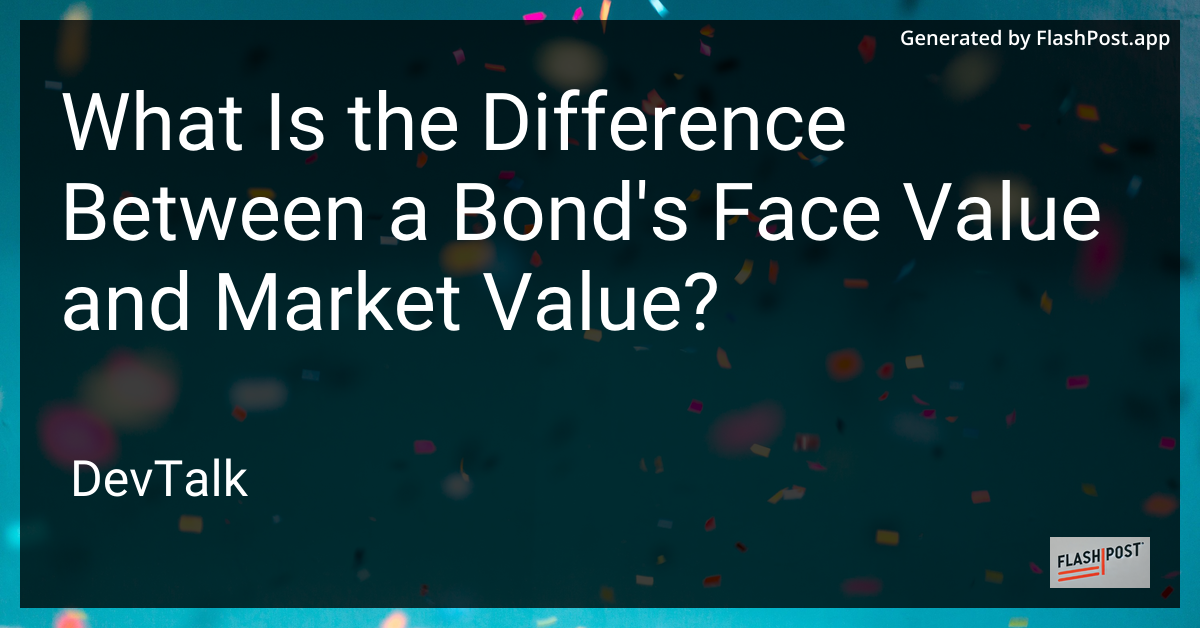What Is the Difference Between a Bond's Face Value and Market Value?
title: Understanding the Difference Between a Bond's Face Value and Market Value
date: 2023-10-11
keywords: bonds, bond face value, bond market value, investment strategies, finance
description: Learn about the difference between a bond's face value and market value to enhance your investment decisions.
Understanding the Difference Between a Bond's Face Value and Market Value
When diving into the world of bonds, two terms you will frequently encounter are face value and market value. Grasping the distinction between these concepts is crucial for making informed investment choices. Let's explore what they each mean and how they affect your investment strategy.
What is a Bond's Face Value?
The face value, also known as the par value or nominal value, is the amount paid back to the bondholder at the maturity date of the bond. It is the original cost of the bond and serves as the benchmark for calculating periodic interest payments, also known as coupon payments. For example, if a bond has a face value of $1,000 and a coupon rate of 5%, it will pay $50 in interest annually.
Key Points about Face Value:
- Face value does not fluctuate with market conditions.
- It is used to calculate interest payments.
- Bondholders receive this amount upon maturity, regardless of the bond's market value at the time.
What is a Bond's Market Value?
In contrast, the market value of a bond is the price at which the bond currently trades in the market. This value is influenced by various factors, including changes in interest rates, credit ratings, and the bond's remaining time to maturity.
Factors Influencing Market Value:
- Interest Rates: When rates rise, bond prices usually fall, and vice versa. This is because new bonds might offer higher interest payments than existing bonds.
- Credit Rating: A bond with a higher credit rating is perceived as less risky and may have a higher market value.
- Time to Maturity: Longer-term bonds are typically more sensitive to interest rate changes, impacting their market value.
Face Value vs. Market Value: The Impact on Investment
Understanding the distinction between face value and market value is vital because it can influence your investment decisions. For instance, if you purchase a bond after its issuance, you may pay more or less than the face value depending on the current market conditions. Knowing how to navigate these differences helps in evaluating potential returns and risks.
Strategic Considerations:
- Purchase Timing: Investors may seek to buy bonds at below face value (discount) to enhance yields.
- Sell Decisions: Knowing the market value can help decide when to sell the bond to maximize profits or minimize losses.
Enhancing your knowledge of bonds is one important step toward becoming a more proficient investor. Moreover, diversifying your portfolio with other investment forms such as investing in dividend stocks, or even considering tech-focused opportunities like Epic Games stock investing, can be vital strategies. For those preferring tangible assets, a beginner's guide to real estate investing might provide valuable insights.
Conclusion
In summary, a bond's face value and market value play distinct roles in bond investments. Recognizing the interaction between these values allows investors to make more informed decisions, potentially leading to better investment outcomes. By broadening your investment knowledge and strategy, you can more effectively navigate the financial markets and achieve your financial goals.
